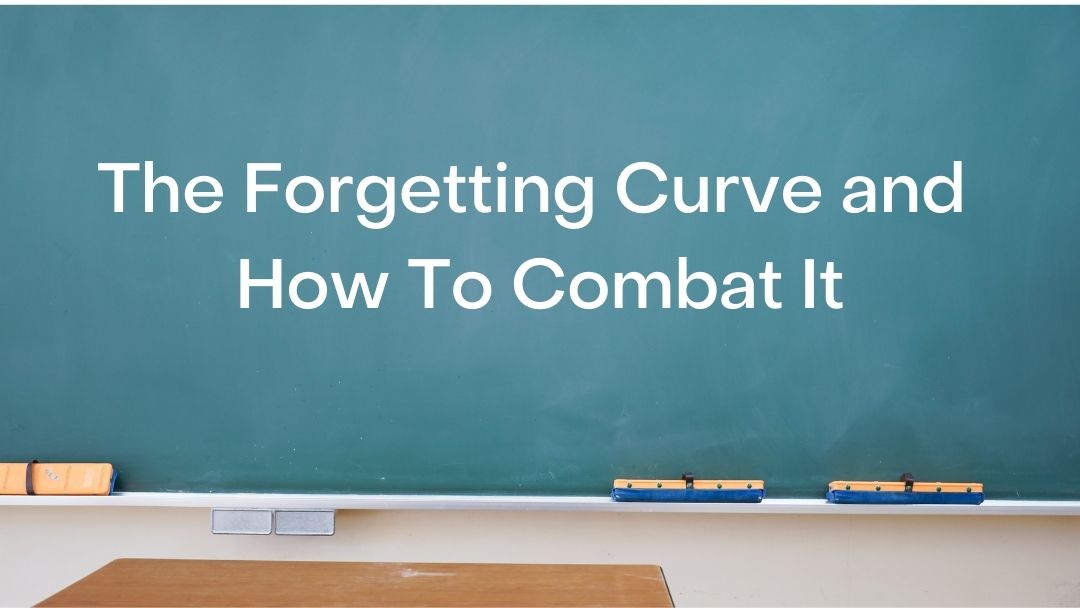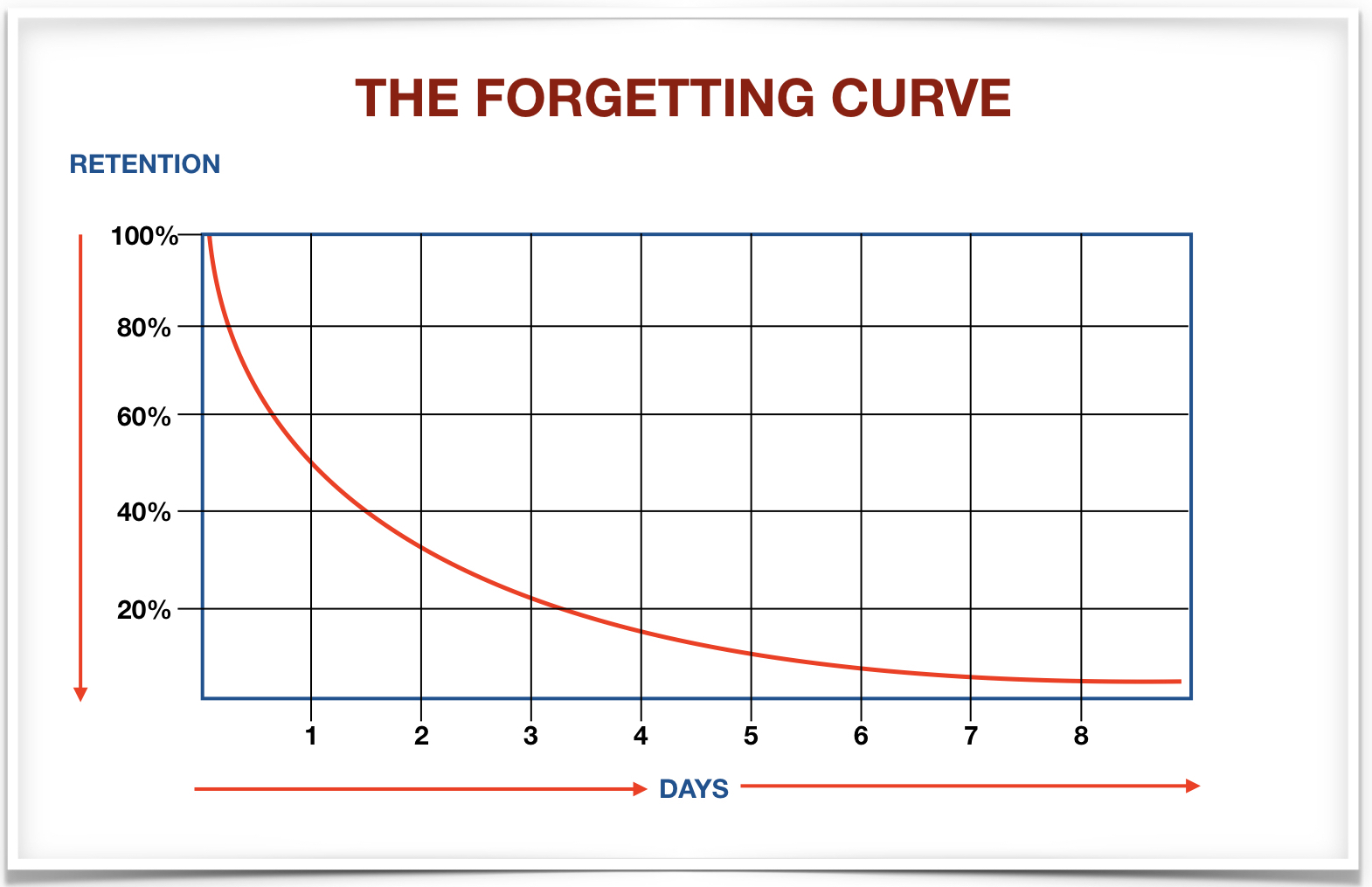What Is The Forgetting Curve (And How Do You Combat It)?
With covid impacting on physical intervention refresher training we must expect that staff who are not being trained will have forgotten most of what they have learned.
This will be compounded by certain factors which can impact information retention.
This blog post highlights how memory is lost over time and what we can do to help retain it – which is fundamentally important for all staff trained in physical intervention and physical intervention trainers.
Hermann Ebbinghaus
In the late 19th century a German psychologist called Hermann Ebbinghaus tested his memory over various periods of time. Once he’d gathered all the data from his spaced learning studies, he plotted it on a graph that looked a little something like this:
The forgetting curve shows how information is lost over time when you don’t try to retain it.
The graph illustrates that when you first learn something, the information disappears at an exponential rate, i.e. you lose most of it in the first couple of days, after which the rate of loss tapers off.
Factors that contribute to the lack of retention (losing information over time) are:
1: The Strength Of The Memory
People can recall stronger memories for a longer period than weaker ones. This is why if an individual is ridiculed or made to feel stupid on a physical intervention course the emotional impact of that will re-enforce that memory and make it stronger. PTSD works in the same way. To combat that we need to have skills that are easy to learn, remember and recall and good positive reinforcement from the training team.
2: The Amount of Time That Has Passed Since The Information Was Learned
According to the forgetting curve and the supporting research, learners will forget an average of 90% of what they have learned within the first month post training, especially if that was the first time they had been trained in those skills.
Is it any wonder therefore, that complex physical intervention training systems result in staff not being able to recall and use the skills when needed.
To combat this good resource material should be provided that a learner can go back to and refresh their memory and maybe additional training, supervision and support offered, especially post incident debriefing after a physical intervention incident.
How To Combat The Forgetting Curve
Now, that we know how memory works, we can do something about it! Here are 4 ways you can leverage spaced repetition to improve recall in your training initiatives.
1: Reinforce The Training Regularly
Every time you reinforce the training, the rate of decline reduces. The testing effect says that by simply testing a person’s memory, that memory will become stronger. Staging frequent training interventions as part of a learning campaign helps solidify the information through active recall.
Therefore, with regards to physical intervention refresher training what can we do in addition to an annual refresher that will help reinforce the initial learning? What about webinars, online learning, cpd events and, if needed, additional training days.
2: Keep The Techniques Simple
Ebbinghaus discovered that information is easier to recall when it’s built upon things you already know. Therefore, any physical skills should be taught around natural movement. People know how to walk, sit, stand, hold and grip.
So why invent techniques that are not natural to do and make people learn a range of specific names that have no correlation to what they are doing.
For example, why say “demonstrate an underhand c-cup hold then transition to an outward rotating double-handed long arm isolation (these words are just made up and not taken from any specific training package), when all is required is “do this, then do that”. Why get staff to learn a ‘new way of sitting down’ when holding and supporting someone in a restraint.
Why can’t they just sit down as they would normally do?
3: Incorporate Different Learning Styles Into Your Training Delivery
Make the information easier to absorb in the first place. Some people prefer more visual information so using diagrams and videos will help them learn more effectively and efficiently. Other people prefer to reflect on things, so case studies will help them.
Some people are more kinaesthetic so need a more ‘hands-on’ approach to learning, and so on (all of these learning styles are covered in our trainer training).
Reading a heavy text-based document can (in some cases) increase information loss and make it easier to forget the meaning or miss it entirely. Think about the last time you wanted to find something out yourself. You probably ‘Googled’ it and looked for a video.
4: Make Your Training More Relevant To What It Needs To Achieve For The Learner
All training must be relevant to what it needs to help the learner achieve. So in a physical intervention training course the strategy, skills and teaching styles must all combine to do just that. In addition, never forget the core purpose of your organization, what we call our ‘Mission Statement’.
A mission statement can help you clarify the core values of your business which should be incorporated throughout your training delivery.
The more relevant the training, the easier it is to recall and if your values shine through so will your integrity that will act as a beacon to inspire and motivate others to learn by adding meaning to what they do.
5: Get Learners Actively Involved
People learn better when they’re actively involved than when they’re just passive observers. Getting learners involved in the training gives them ownership and ownership increases involvement.
We’ve all had the ‘death by powerpoint’ type training course so we can all relate to that!
The fact is, if you don’t give your learners an opportunity to interact with the content, they’ll lose concentration and drift off. Adding case studies, quizzes, questions and answer sessions, etc. are great ways to keep your learners involved and enjoy your training!
March 2021 Restraint Trainer Refresher Courses
We are holding our March 2021 Combined Restraint & Handcuff Trainer Refresher Course on the 23rd, 24th and 25th March. These courses will help reinforce your teaching ability as well as giving you the opportunity to upskill to a Level 3 Assessors Award as part of your professional CPD.
Places are limited (due to covid) and you can find out more here –


